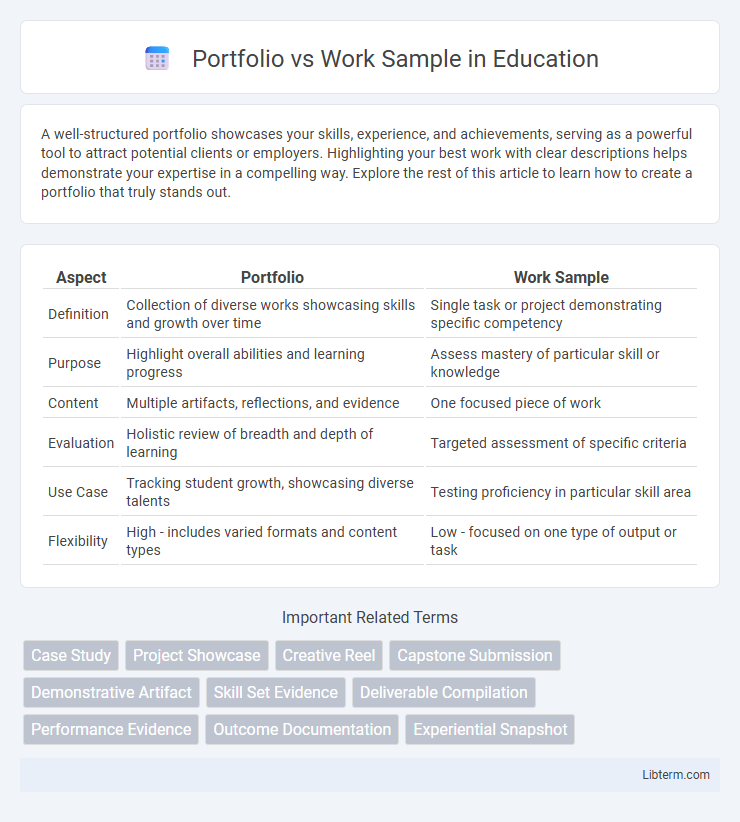A well-structured portfolio showcases your skills, experience, and achievements, serving as a powerful tool to attract potential clients or employers. Highlighting your best work with clear descriptions helps demonstrate your expertise in a compelling way. Explore the rest of this article to learn how to create a portfolio that truly stands out.
Table of Comparison
| Aspect | Portfolio | Work Sample |
|---|---|---|
| Definition | Collection of diverse works showcasing skills and growth over time | Single task or project demonstrating specific competency |
| Purpose | Highlight overall abilities and learning progress | Assess mastery of particular skill or knowledge |
| Content | Multiple artifacts, reflections, and evidence | One focused piece of work |
| Evaluation | Holistic review of breadth and depth of learning | Targeted assessment of specific criteria |
| Use Case | Tracking student growth, showcasing diverse talents | Testing proficiency in particular skill area |
| Flexibility | High - includes varied formats and content types | Low - focused on one type of output or task |
Understanding Portfolios vs Work Samples
Portfolios showcase a curated collection of projects demonstrating diverse skills and experiences across multiple contexts, providing a comprehensive overview of a person's capabilities. Work samples focus on specific tasks or completed assignments that highlight proficiency in particular areas or specialties. Understanding the distinction helps employers assess overall versatility through portfolios, while work samples allow evaluation of targeted expertise and quality in a real-world setting.
Defining Portfolio: Scope and Purpose
A portfolio is a curated collection of work showcasing a broad range of skills, experiences, and achievements, designed to demonstrate versatility and growth over time. Its scope includes diverse project types, case studies, and reflective commentary, supporting a comprehensive narrative about the creator's professional journey. The purpose of a portfolio is to provide potential employers or clients with a holistic view of capabilities, creative process, and real-world applications across multiple contexts.
What Constitutes a Work Sample?
A work sample consists of specific pieces of completed tasks or projects that directly demonstrate an individual's skills, expertise, and problem-solving abilities in a tangible format. Unlike a broader portfolio that may include a variety of materials such as resumes or project descriptions, a work sample provides concrete evidence of one's professional capabilities through actual deliverables like reports, designs, code snippets, or presentations. This targeted showcase helps potential employers or clients assess real-world performance and proficiency relevant to the job or project requirements.
Key Differences Between Portfolio and Work Sample
A portfolio is a curated collection showcasing a range of projects highlighting diverse skills and experiences, while a work sample typically represents a single piece demonstrating specific expertise or quality of work. Portfolios provide a comprehensive overview of an individual's capabilities across various tasks, whereas work samples focus on depth and detail in a particular area. The key difference lies in scope: portfolios emphasize breadth, and work samples emphasize specialization.
When to Use a Portfolio
Use a portfolio when showcasing a comprehensive collection of work that demonstrates a range of skills, growth, and versatility over time, ideal for creative professions like design, writing, and photography. Portfolios effectively communicate a professional's development process and include diverse projects, client work, and personal achievements. They are particularly useful during job applications, client pitches, or academic submissions where illustrating progression and breadth is crucial.
Situations Favoring Work Samples
Work samples excel in hiring processes requiring direct assessment of job-specific skills, such as coding tests for software developers or writing tasks for content creators. They offer tangible evidence of a candidate's abilities in real-world scenarios, reducing reliance on self-reported experience found in portfolios. Situations favoring work samples include roles with clearly defined tasks and measurable outcomes, enhancing prediction accuracy of job performance.
Benefits of Showcasing a Portfolio
Showcasing a portfolio provides a comprehensive representation of skills, creativity, and growth, allowing potential clients or employers to assess the quality and range of your work effectively. Unlike individual work samples, portfolios offer contextual insights by grouping projects that demonstrate versatility and consistent performance across various challenges. A well-organized portfolio enhances credibility, builds trust, and increases the chances of securing new opportunities by presenting a professional narrative of your expertise.
Advantages of Submitting Work Samples
Submitting work samples provides tangible evidence of skills and expertise, allowing potential employers to directly evaluate the quality and style of your output. Work samples highlight specific projects or tasks relevant to the job, demonstrating practical experience and problem-solving abilities that a portfolio overview might not fully capture. This targeted approach increases credibility and enhances the chances of securing interviews by showcasing real-world accomplishments.
Choosing the Right Format for Your Career Goals
Selecting the appropriate format between a portfolio and work samples depends on your career objectives and industry standards. Portfolios offer a comprehensive showcase of your skills and growth, ideal for creative fields like design and photography, whereas work samples provide focused evidence of specific expertise, suitable for technical roles such as writing or engineering. Aligning your presentation choice with prospective employers' expectations enhances your chances of demonstrating relevant competencies effectively.
Combining Portfolios and Work Samples Effectively
Combining portfolios and work samples effectively enhances the demonstration of skills by providing a comprehensive view of creativity and technical proficiency. Portfolios showcase a curated collection of completed projects, highlighting versatility and consistency, while work samples offer detailed insights into specific tasks or problem-solving approaches. Integrating both elements allows professionals to present a balanced narrative, improving engagement with potential employers or clients through tangible evidence of expertise and process.
Portfolio Infographic

 libterm.com
libterm.com